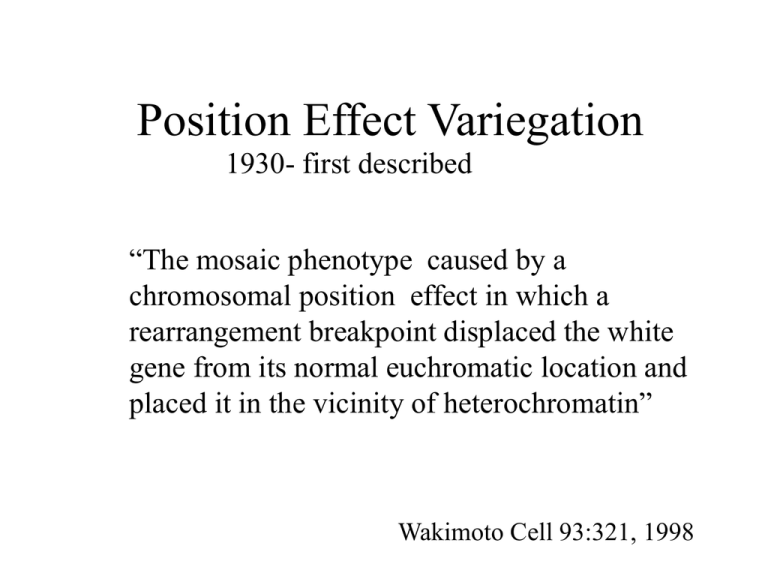Position Effect Variegation
advertisement

Position Effect Variegation 1930- first described “The mosaic phenotype caused by a chromosomal position effect in which a rearrangement breakpoint displaced the white gene from its normal euchromatic location and placed it in the vicinity of heterochromatin” Wakimoto Cell 93:321, 1998 Position effect variegation- pp448, Alberts Definition- Translocation of a gene from a euchromatic region to a heterochromatic region resulting in inactivation of nearby heterochromatic genes. – Called “heterochromatic spreading”, but is an incomplete definition Position Effect Variegation The white gene produces red eyes Variegated Wild-type Dorer and Henikoff Cell 77:993, 1994 PEV- effect of transgene repeats • Single copy of “mini-white” locus inserted near centromere in null-white fly strain Heterochromatin Inverted repeat Single copy tandem repeat three repeats four repeats Thus, repeat number and orientation affect PEV PEV can be suppressed by modifiers controls Six-copy mini-white gene at 50C in Su(var)295 flys Advanced Molecular and Cellular Biology Bio4751 Spring 2003 Gary A. Bulla, PhD Models of PEV A. Cis-spreading Note: Histone acetylation effects PEV 1. Cis-spreading, block factor binding 2. Cis-spreading, form repressor complex with factors Thus, more spreading = more variegation Advanced Molecular and Cellular Biology Bio4751 Spring 2003 Gary A. Bulla, PhD Models of PEV A. Cis-spreading Problems with cis-spreading model • Some hetero-euchromatin rearrangements induce PEV several megabases away • PEV is sensitive to interchromosomal interactions • Thus, trans-interactions are suggested Models B. Nuclear compartment model A trans-effect model Evidence in support• Centromeres and most heterochromatin is located at one end of nucleus, telomeres at opposite end • Displaced heterochromatic regions interact with other heterochromatic regions – prevented by modifiers of PEV • However- have not yet correlated measured transcriptional activity and nuclear localization Advanced Molecular and Cellular Biology Bio4751 Spring 2003 Gary A. Bulla, PhD How does PEV Occur? Lets look at Telomere Position Effect RAP1• Telomere Position Effect- Rap1 in complex with SIR proteins (SIR2/SIR3/SIR4) and histones H4 + H3 – Functions- heterochromatin assembly; recruitment of SIR proteins Folding-back mechanism Advanced Molecular and Cellular Biology Bio4751 Spring 2003 Gary A. Bulla, PhD Models of PEV • Over 120 modifiers (enhancers and suppressors) of PEV identified • Only some are directly involved • HP-1, Su(var)3-7 both co-localize to heterochromatin, interact in yeast two hybrid assay – Neither binds DNA Advanced Molecular and Cellular Biology Bio4751 Spring 2003 Gary A. Bulla, PhD What about genes normally active in heterochromatin? • Flys have over 20 expressed genes located in heterochromatin • >7 of these genes require placement in heterochromatin for normal expression • If place into euchromatic region- PEV results! • 1/2 of mutations that suppress PEV of euchrom. genes also enhance PEV of heterochrom. genes Advanced Molecular and Cellular Biology Bio4751 Spring 2003 Gary A. Bulla, PhD What about genes normally active in heterochromatin? Heterochromatin binding proteins interact with transcription factors to activate transcritpion or mediate longrange enhancerpromoter communication Thus, Rap1p may may have repressor role in euchromatin, activator role in heterochromatin Advanced Molecular and Cellular Biology Bio4751 Spring 2003 Gary A. Bulla, PhD How is PEV maintained? • No current model is satisfactory • Not DNA methylation -(Flys don’t do this) • GAGA protein binds to heterochromatin, remains throughout cell cycle • DNA must be “tagged” to maintain a given level of PEV during subsequent cell divisions • Competition for factors at each cell cycle? Advanced Molecular and Cellular Biology Bio4751 Spring 2003 Gary A. Bulla, PhD Recent result • What happens if have two genes (GFP and miniwhite) near centromere? Gal4-responsive Green Fluor. Protein Mini-white gene Centromere Ahmad and Henikoff, Cell 104:839, 2001. Ahmad and Henikoff, Cell 104:839, 2001. GFP in GFP in near euchromatin heterochromatin • Observe GFP expression is variegated next to heterochromatin •And as increase High GAL4 Gal4, suppress variegation Low GAL4 Euchrom. Heterochrom. Ahmad and Henikoff, Cell 104:839, 2001. What happens to a nearby gene (the mini-white gene)? Miniwhite in euchromatin GAL4? No Yes Miniwhite near heterochromatin No Yes Thus, GAL4 binding counteracts silencing at nearby mini-white locus Ahmad and Henikoff, Cell 104:839, 2001. Can GFP and mini-white variegation be uncoupled? Miniwhite near heterochromatin Note- GFP on, mini-white off!! •Thus, GFP and mini-white silencing can be uncoupled.! •Heterochromatic boundary may be within 2 kb of DNA. •Heterochomatic spreading in not continuous









